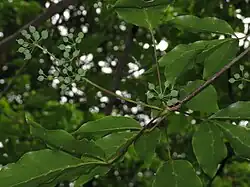鷹の爪
Japanese

鷹の爪 (taka no tsume, the chili): a chili of similar shape to a common taka no tsume.

| Kanji in this term | |
|---|---|
| 鷹 | 爪 |
| たか Jinmeiyō |
つめ Grade: S |
| kun’yomi | |
Etymology
Compound of 鷹 (taka, “hawk, falcon”) + の (no, possessive particle) + 爪 (tsume, “claw, talon”).[1]
Noun
鷹の爪 • (taka no tsume)
- Gamblea innovans, a deciduous tree native to Japan, used for its wood (possibly so called for the way the leaves grow in groups of three, similar to a hawk's claws)
- a kind of chili (Capsicum annuum) that is curved and slender, used for pickling (so called for the way the shape resembles a hawk's claw)
- a kind of high-quality tea (so called for the way guests may decide to stay longer to partake, as if caught by a claw)
- alternate name for 爪草 (tsumekusa), the Japanese pearlwort or Sagina japonica
Usage notes
As with many terms that name organisms, this term is often spelled in katakana, especially in biological contexts (where katakana is customary), as タカノツメ.
References
- Shōgaku Tosho (1988) 国語大辞典(新装版) [Unabridged Dictionary of Japanese (Revised Edition)] (in Japanese), Tōkyō: Shogakukan, →ISBN
- Matsumura, Akira, editor (2006), 大辞林 [Daijirin] (in Japanese), Third edition, Tōkyō: Sanseidō, →ISBN
This article is issued from Wiktionary. The text is licensed under Creative Commons - Attribution - Sharealike. Additional terms may apply for the media files.